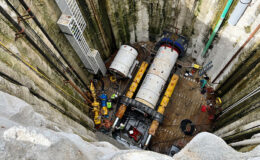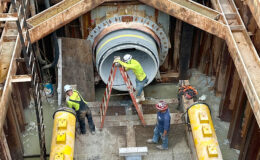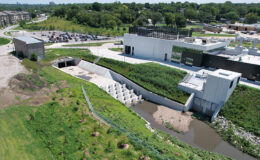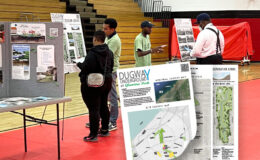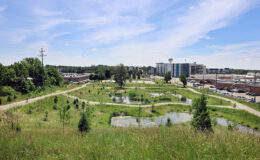By David Anthony, RLA, AICP
Green infrastructure practices are being integrated into conventional stormwater management approaches for communities across the US. Encouraged by regulatory agencies, green infrastructure and low impact development approaches are being folded into comprehensive programs for municipal separate storm sewer systems, combined sewer overflow (CSO) management, and Total Maximum Daily Loads, to improve water quality while enhancing communities. While green solutions such as porous pavement or stormwater treatment wetlands, are often implemented for a site-specific issue, solutions that are implemented using a broader, green watershed planning strategy offer greater value and ecological benefit.
A green watershed planning strategy combines gray stormwater source controls, such as a separate stormwater conveyance network or stormwater retention basin, with natural systems that capture, cleanse and reduce stormwater runoff using plants, soils and microbes. This approach seeks to create an interconnected network of open spaces and natural areas (forests, floodplains and wetlands) that improve water quality, recreational opportunities and wildlife habitat in a watershed.
Wade Trim is working with several clean water agencies and large cities to integrate green infrastructure practices as components of integrated gray and green stormwater management strategies and wet weather CSO management plans. Green practices are also serving as a catalyst for implementing community enhancements such as neighborhood stabilization, land banking strategies, recreation and open space network expansion. The major benefits of applying an integrated approach to stormwater management include:
• Peak flow reductions and flood control
• Water quality improvements
• Community enhancements
• CSO management
On a regional scale, green stormwater management strategies help preserve and restore the hydrologic functions of watersheds, reducing peak flows and providing flood control during wet weather events. On the site or neighborhood scale, a variety of structural and non-structural controls are used to mimic a site’s predevelopment hydrology using design techniques that infiltrate, filter, store, evaporate and detain runoff close to its source. Because green infrastructure practices address low-volume storm events, usually about 1 inch of rain, they should be used to supplement, not replace, gray stormwater management techniques to mitigate flooding problem areas.
Green practices can be used to protect and preserve surface and ground water quality as well as the integrity of receiving streams. A treatment train of pollutant absorbing practices that efficiently remove sediment, metals, nutrients, oil, grease and, in some cases, bacteria, from runoff can help manage the first flush of pollutants from rain storms. Though the treatment efficacy of many green stormwater practices is not well documented, long-term studies continue to provide reliable data that proves the effectiveness of these practices to improve the water quality of lakes and streams.
As communities seek to enhance their economic viability, green infrastructure offers a way to address environmental issues while improving quality of life. During development, major cities across the US managed wet weather flow to protect people and infrastructure by directing natural waterways to underground pipes and replacing natural drainage ways with storm sewer systems. In many cases, this approach has undermined local and regional ecosystems and limited the ability of nature to provide flood protection, air purification, climate regulation, erosion control and biological habitat. Large-scale green infrastructure practices can be used to recreate the functions of healthy ecosystems, so natural processes are harnessed for community and environmental enhancements. Healthy ecosystems also contribute to the well-being of residents by providing access to natural areas and outdoor recreation.
The watershed systems approach requires a plan that embraces the unique set of conditions and circumstances of each project, site and community. Planning must be community-centric and address multiple objectives whenever possible to ensure that it is embraced by the affected community and becomes a community asset.
Wet weather management strategies are increasingly adding green stormwater practices as part of CSO implementation plans. Gray infrastructure controls include deep tunnel systems, wastewater treatment plant upgrades, in-line storage facilities, relief sewers, pump station upgrades, and treatment/disinfection facilities. Green infrastructure control measures are applied as strategic separation, offloading and stormwater source control practices and should be combined with gray controls to optimize the plan. While green and gray controls have competing design criteria, when layered in over the sewershed, they can effectively manage frequent, low-volume events and reduce the size and complexity of gray controls.
The Metropolitan Sewer District of Greater Cincinnati (MSDGC) is implementing its Wet Weather Improvement Plan through a series of projects or bundles to address CSOs and sanitary sewer overflows (SSOs) in different sections of its service area. Wade Trim is designing improvements for the Upper Duck All Bundle to control overflows in the Duck Creek Watershed including planning and detailed design for an integrated stormwater and CSO management plan. Green infrastructure strategies will be incorporated to reduce CSO volumes in this highly urbanized sewershed.
As part of the City of Omaha’s Long Term Control Plan, a preliminary study of the Leavenworth CSO Basin was conducted to recommend green alternatives that would complement the structural CSO controls identified for two CSO outfalls in the Basin. Stormwater source control Best Management Practices (BMPs) are proposed to reduce the volume of wet weather runoff entering their combined sewer system. Recommendations will be evaluated by the City and its Program Management Team to determine which green solutions will be incorporated into the final Plan.
Integrating natural processes and man-made structures provides a more sustainable approach to managing stormwater. Green infrastructure can reduce the volume of stormwater before it leaves a site, putting less strain on traditional stormwater collection and conveyance systems while providing multiple environmental and community benefits to a site or watershed.
Dave Anthony, RLA, AICP, has 32 years of experience in environmental planning, ecological restoration and landscape architecture. He has evaluated and designed green infrastructure solutions for water resources projects in Cleveland, Cincinnati, Pittsburgh, Detroit, Indianapolis, Omaha and Southwest Florida. He can be reached at danthony@wadetrim.com or 734.947.9700.

Wade Trim is evaluating green infrastructure opportunities such as using porous pavement and bioretention in this community park to reduce stormwater inflows to the Allegheny County Sanitary Authority’s collection system in Pittsburgh, PA.


